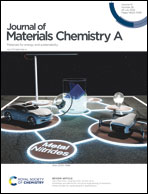Graphene-encapsulated selenium@polyaniline nanowires with three-dimensional hierarchical architecture for high-capacity aluminum–selenium batteries†
Abstract
The elementary selenium (Se) and intermediate product Se2Cl2 in aluminum–selenium batteries (ASBs) are prone to chemical and electrochemical dissolution in an acidic AlCl3-based ionic liquid electrolyte, which leads to serious structural collapse and capacity decay. Therefore, it is highly desirable to inhibit the dissolution by a rational morphology and structure engineering strategy. Here, we fabricated a three-dimensional hierarchical architecture by encapsulating polyaniline (PANI) coated selenium nanowires in the graphene (G) matrix (Se@PANI@G), which was expected to accelerate the kinetic process and improve the cycling performance. Se nanowires are well sealed in a PANI layer with a thickness of 15 nm, and then the constructed Se@PANI core–shell nanowires are uniformly encapsulated in graphene nanosheets to form a three-dimensional hierarchical architecture of Se@PANI@G. As a result, the ASBs with the as-prepared Se@PANI@G composite positive electrode can deliver a high specific capacity of ∼445.5 mA h g−1 during the 2nd cycle at a current density of 200 mA g−1, with a retained discharge specific capacity of 164.0 mA h g−1 after 160 cycles. The improved cycling performance can be associated with the high electrical conductivity of graphene sheets and the unique PANI shell, together with the three-dimensional hierarchical architecture of Se@PANI@G.



 Please wait while we load your content...
Please wait while we load your content...